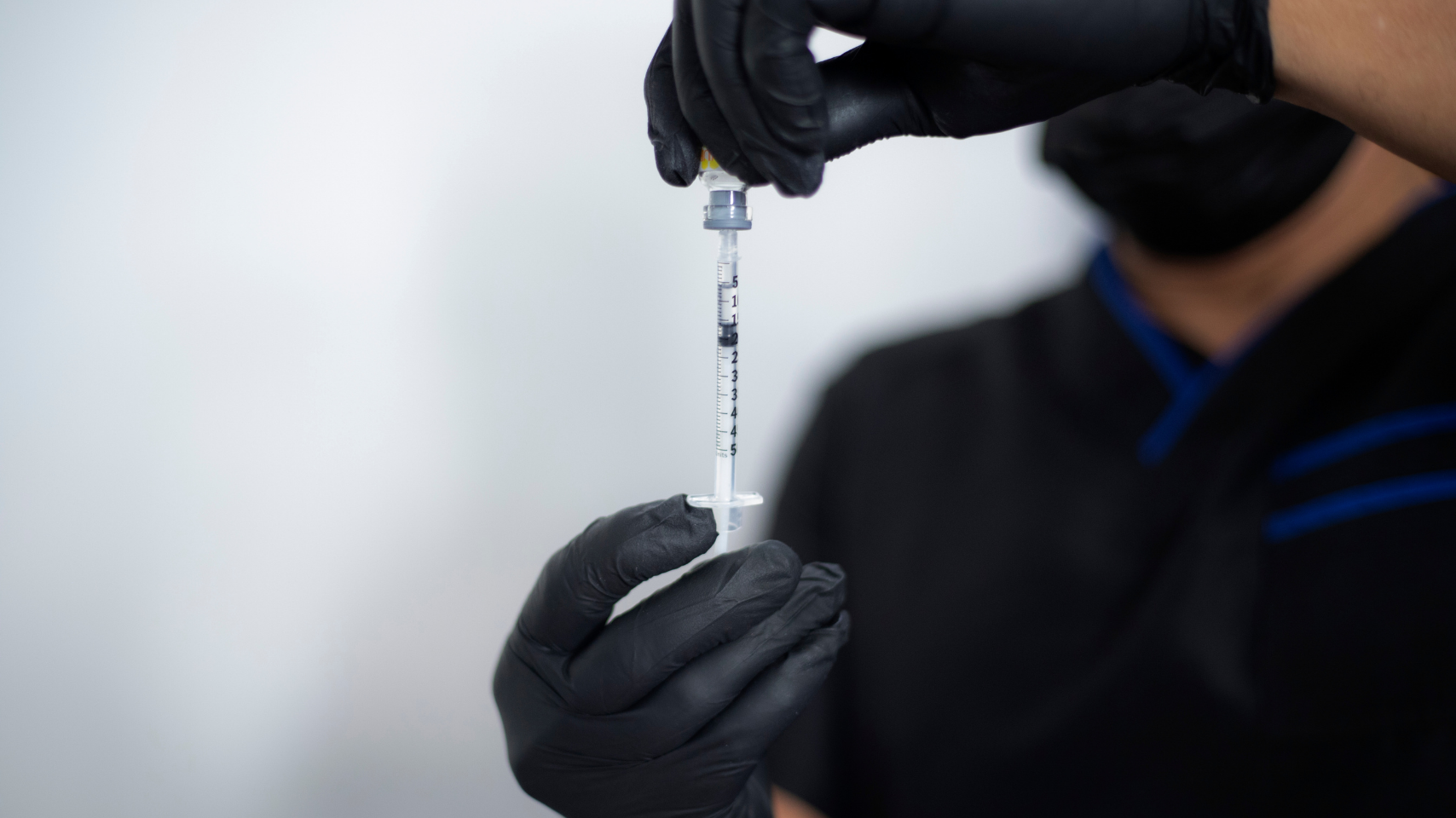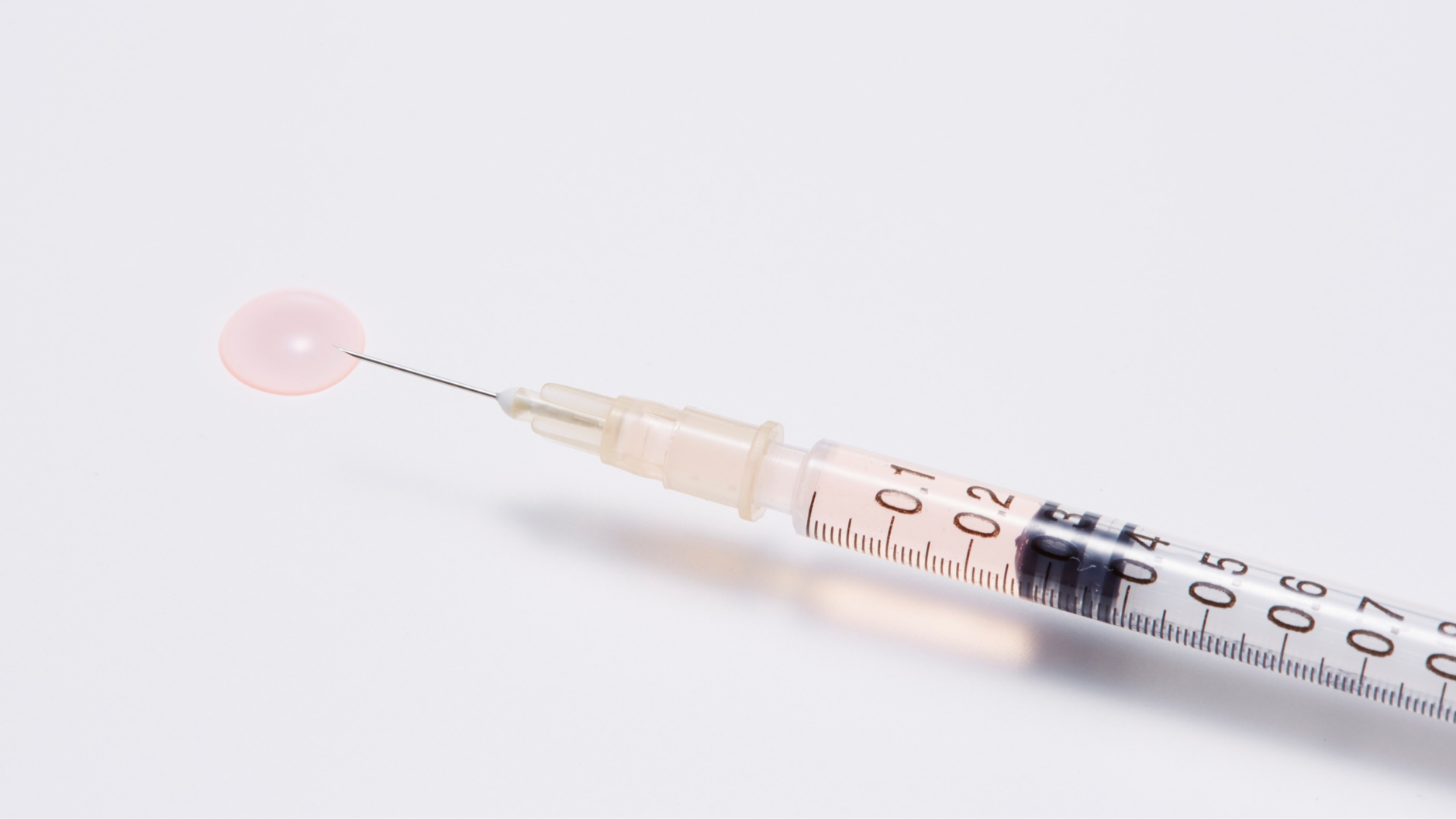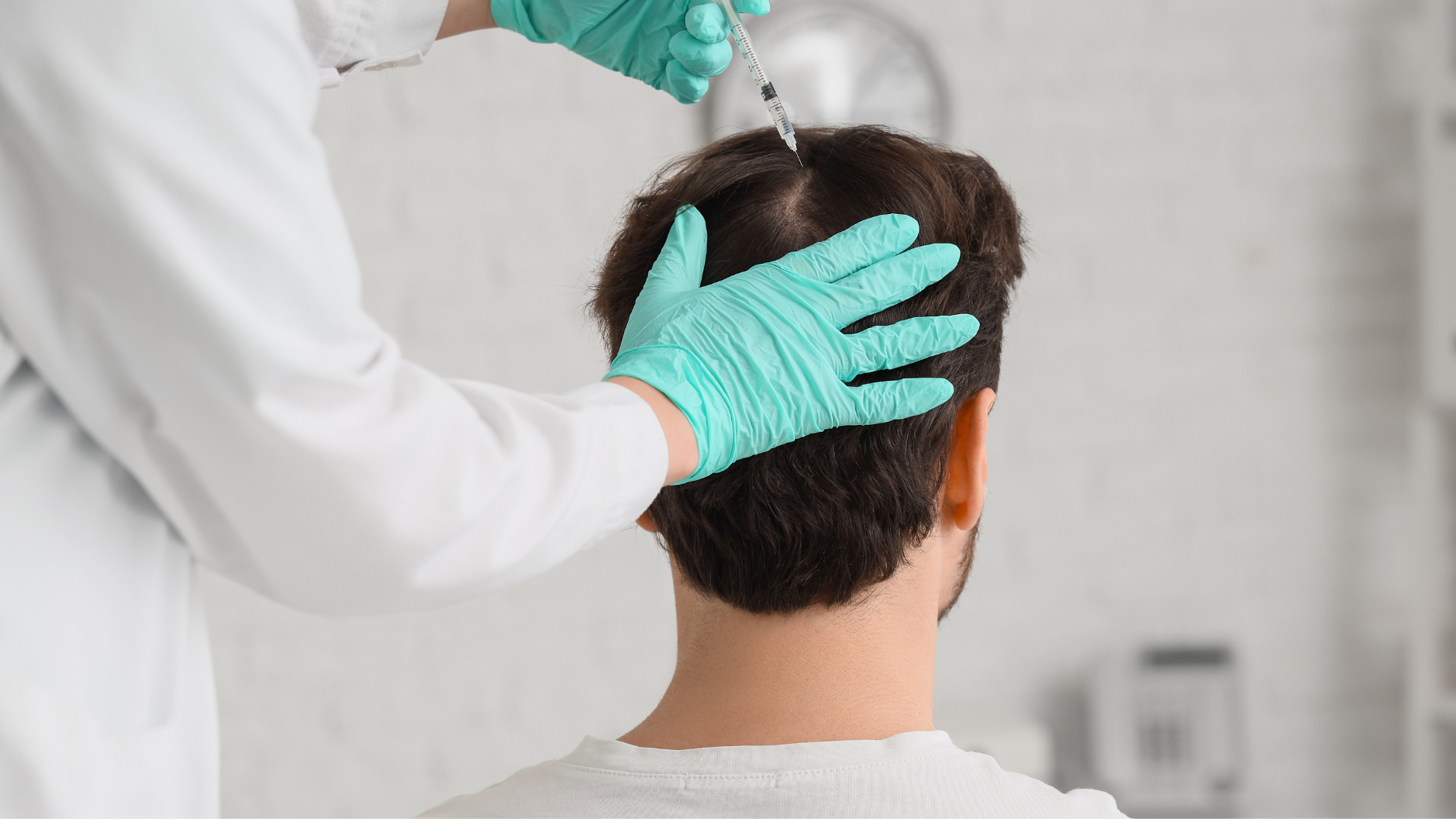Mesotherapy for hair loss: An evidence-based guide (2025)
Once dismissed as a cosmetic trend, mesotherapy is now emerging as one of the most promising and personalised solutions in non-surgical hair restoration and the science behind it is catching up fast. By delivering active compounds directly into the scalp, mesotherapy aims to support the environment around the hair follicle, helping to stimulate growth, reduce shedding, and improve scalp health.
This guide explains how mesotherapy works, what the research says, and who it might benefit most, based on the latest clinical data.

What is mesotherapy?
Mesotherapy is a treatment that involves tiny injections into the upper layers of the scalp. These injections carry a combination of ingredients such as hyaluronic acid, amino acids, vitamins, peptides, and sometimes prescription medications.
The goal is to deliver these substances into the layers of the skin where the hair follicles are supported by blood vessels and structural cells. This may help to hydrate the scalp, improve circulation, reduce inflammation, and stimulate the growth phase of the hair cycle.
Some of the most commonly used ingredients include hyaluronic acid for hydration, amino acids and biotin to support keratin manufacture, growth factors and peptides for follicle repair and caffeine or DHT-blockers such as dutasteride to counter hormonal drivers of hair loss. Other additions such as antioxidants and niacinamide or probiotic lysates may help reduce oxidative stress or support the skin barrier and microbiome.
Who is it best for?
Mesotherapy is most effective for people experiencing the early stages of androgenetic alopecia. It can also be beneficial in telogen effluvium, which is a form of shedding triggered by stress, illness, or nutritional issues, once any underlying causes have been corrected.
People with dry or sensitive scalps may benefit from barrier-repairing formulations that improve scalp hydration and comfort. It is also an option for those who prefer not to use oral medications like finasteride.
Mesotherapy is not suitable for individuals with active autoimmune scalp disorders, including alopecia areata, lichen planopilaris, scalp infections or uncontrolled medical conditions that impair healing. In these situations, mesotherapy could worsen inflammation or fail to provide benefit.
How does it work?
The mechanism of action depends on the formulation used. For example, caffeine helps stimulate the follicle by increasing cell energy and countering the effects of DHT. Growth factor peptides such as VEGF and IGF-1 can encourage blood vessel growth around the follicles and improve nutrient delivery. Hyaluronic acid increases hydration and may reduce scalp irritation. Amino acids contribute to the building blocks of the hair shaft, while antioxidants help defend against damage from oxidative stress.
Mesotherapy may also stimulate circulation through the injection process itself, enhancing the effects of the ingredients used.
What does the research show?
Several clinical trials have evaluated mesotherapy in the treatment of hair loss. Studies using dutasteride-based solutions have shown meaningful increases in hair count and density. Formulations rich in growth factors or peptides have also demonstrated improvements in hair shaft thickness and follicular activity. Mesotherapy has been show to be effective as a standalone treatment or when combined with other therapies such as topical minoxidil or oral finasteride.
Intradermal minoxidil has outperformed topical application in some trials, particularly in improving the percentage of hairs in the anagen (growth) phase.
Although the size and quality of studies vary, early intervention appears to produce the most noticeable outcomes. Combining mesotherapy with other evidence-based treatments also seems to improve results.
How is it done?
A typical treatment protocol includes three to six sessions, spaced every two to four weeks. Maintenance treatments may follow every three to six months, depending on response.
The depth of injection ranges from shallow delivery for hydration (approximately 0.25 mm) to deeper injection into the mid dermis for follicular support (up to 2 mm). Fine needles are used to minimise discomfort. Redness or swelling may occur after treatment but usually resolves within 24 hours.
Choosing the right mesotherpay ingredients
One of the strengths of mesotherapy is the ability to tailor treatment to the person’s specific needs.
In androgenetic alopecia, the priority is often to reduce the impact of DHT and support hair follicle metabolism. Formulations here might include dutasteride, caffeine, peptides, and minoxidil.
For telogen effluvium, ingredients such as amino acids, copper peptides, and antioxidants are more appropriate, as they help rebuild strength and reduce oxidative damage.
For sensitive or barrier-impaired scalps, formulations often include hydrating agents like hyaluronic acid, niacinamide, or ceramides, which support the skin’s ability to retain moisture and resist irritation.
Mesotherapy vs. PRP and exosomes
Although mesotherapy, PRP, and exosome therapy are often grouped together as treatments for hair loss, each method works differently and offers distinct advantages depending on the patient and the clinical context.
PRP, or platelet-rich plasma, is made by drawing a small amount of the patient’s blood, spinning it in a centrifuge, and concentrating the platelets to three to five times above baseline levels. When injected into the scalp, these platelets release growth factors such as VEGF, PDGF, and IGF-1, which are known to support blood vessel development and fgrowth factor signalling. However, the activity of these platelets is short-lived. Most of the injected growth factors are released within hours to a few days, which is why multiple sessions are typically recommended to sustain results.
The success of PRP also depends heavily on the quality of the patient’s own blood. Low iron stores, can impair platelet production and function, reducing the growth factor yield during centrifugation. Zinc deficiency may interfere with platelet aggregation and signalling, affecting how effectively they stimulate local repair. Patients with poorly controlled thyroid function, vitamin D deficiency, or elevated blood sugar may also respond less robustly, as these systemic conditions can weaken vascular function and tissue responsiveness.
Yet, PRP can deliver excellent outcomes in the right patient, particularly when the individual is metabolically stable, iron replete, and has no major inflammatory conditions.
Exosomes are extracellular vesicles that can be derived from sources such as bovine colostrum, donor stem cells, or lab-manufactured systems designed to mimic natural signalling. These microscopic carriers contain proteins, lipids, messenger RNA, and microRNA. When injected, they are believed to deliver a biological signal that promotes dermal remodelling, angiogenesis, and follicular repair. Early studies have shown improvements in hair density and shaft thickness over three to six months, although long-term safety and efficacy data are still limited. The effects of exosomes may vary depending on the preparation method, the product source, and the tissue readiness of the individual receiving the treatment.
Exosomes are not influenced by the patient’s nutritional or hormonal status in the same way PRP is, but the recipient’s biological readiness still matters. If the local tissue environment is inflamed, fibrotic, or metabolically compromised, exosome signalling may not produce the intended regenerative response. Additionally, exosome therapy remains costly and less accessible than other options.
Mesotherapy stands out for its adaptability. Rather than relying on blood-derived or stem cell products, it uses formulated blends of biologically active ingredients. These can include vitamins, peptides, hyaluronic acid, amino acids, or prescription agents like dutasteride or minoxidil. Because these ingredients can be selected based on the patient’s diagnosis, mesotherapy offers a highly customisable approach. It is also more cost-effective and does not rely on autologous preparation, making it ideal for patients who are not suitable candidates for PRP or exosomes.
Crucially, most clinical trials investigating mesotherapy, PRP, and exosome therapy exclude individuals with active systemic drivers of hair loss. These include iron deficiency, thyroid imbalance, insulin resistance, chronic inflammation, and autoimmune disease. When these underlying factors are not corrected, even the most biologically sophisticated treatment may fall short. For that reason, it is essential that individuals seek the advice of a qualified dermatologist or clinical trichologist before starting any injectable hair restoration treatment, to ensure that underlying causes of hair loss have been properly identified and addressed.
Ultimately, the choice between mesotherapy, PRP, and exosomes should depend on three factors: the individual’s diagnosis, the condition of their scalp and overall health, and practical considerations such as treatment cost and product availability. Each method has a place in clinical trichology when used appropriately, and all are most effective when combined with a broader strategy that addresses both local scalp issues and underlying systemic contributors to hair loss.
Is mesotherapy worth trying?
Mesotherapy will not reverse years of hair loss overnight. However, when used in the right patient, at the right stage of hair loss, and alongside other supportive treatments, it can lead to real improvement in hair density, shedding control, and scalp comfort.
Success depends on selecting the right candidate, customising the formula appropriately, and ensuring any underlying deficiencies or health conditions are also addressed. When done correctly, mesotherapy can be a powerful addition to a personalised hair restoration plan.
Frequently Asked Questions
How long before I see results?
Most people begin to notice improvement after three to four months. Initial shedding may still occur in the early weeks.
Is mesotherapy painful?
The treatment causes mild stinging or pressure, but most patients tolerate it well.
How many sessions will I need?
Typically three to six sessions are recommended, followed by maintenance every few months if needed.
Can I use it with other treatments?
Yes. Mesotherapy works well alongside topical minoxidil, nutritional supplements, and low-level light therapy.
Is it safe for autoimmune or scarring hair loss?
Not during the active phase. It should only be considered once inflammation is under control and the scalp is stable.
References
-
Abdallah M, El-Zawahry KA, Besar H. Mesotherapy using dutasteride-containing solution in male pattern hair loss: a controlled pilot study. J Pan Arab Leag Dermatol. 2009;20:137–145.
-
Papakonstantinou E, Roth M, Karakiulakis G. Hyaluronic acid: a key molecule in skin aging. Dermato-endocrinol. 2012;4(3):253–258.
-
Md Fadilah NI, Shahabudin NA, Mohd Razif RA, Sanyal A, Ghosh A, Baharin KI, et al. Discovery of bioactive peptides as therapeutic agents for skin wound repair. J Tissue Eng. 2024;15:20417314241280359.
-
Quan T, Wang F, Shao Y, Rittié L, Xia W, Orringer JS, et al. Enhancing structural support of the dermal microenvironment activates fibroblasts, endothelial cells, and keratinocytes in aged human skin in vivo. J Invest Dermatol. 2013;133(3):658–667.
-
Patel DP, Swink SM, Castelo-Soccio L. A review of the use of biotin for hair loss. Skin Appendage Disord. 2017;3(3):166–169.
-
Rushton DH. Nutritional factors and hair loss. Clin Exp Dermatol. 2002;27(5):396–404.
-
Pickart L, Margolina A. Regenerative and protective actions of the GHK-Cu peptide in the light of the new gene data. Int J Mol Sci. 2018;19(7):1987.
-
Yano K, Brown LF, Detmar M. Control of hair growth and follicle size by VEGF-mediated angiogenesis. J Clin Invest. 2001;107(4):409–417.
-
Fischer TW, Herczeg-Lisztes E, Funk W, Zillikens D, Bíró T, Paus R. Differential effects of caffeine on hair shaft elongation and hair follicle biology in vitro. Br J Dermatol. 2014;171(5):1031–1043.
-
Kwon OS, Han JH, Yoo HG, Chung JH, Cho KH, Eun HC, et al. Human hair growth enhancement in vitro by green tea epigallocatechin-3-gallate (EGCG). Phytomedicine. 2007;14(7–8):551–555.
-
Sudeep HV, Rashmi S, Jestin TV, Richards A, Gouthamchandra K, Shyamprasad K. Oral and topical administration of standardized saw palmetto oil reduces hair fall and improves hair growth in androgenetic alopecia subjects: a 16-week randomized, placebo-controlled study. Clin Cosmet Investig Dermatol. 2023;16:3251–3266.
-
Rushton DH. Nutritional factors and hair loss. Clin Exp Dermatol. 2021;46(3):561–566.
-
Watanabe S. Skin microbiome and cutaneous disease. Exp Dermatol. 2017;26(5):393–396.
-
Elias PM, Steinhoff M. “Outside-to-inside” (and now back to “outside”) pathogenic mechanisms in atopic dermatitis. J Invest Dermatol. 2008;128(5):1067–1070.
-
Sobhy N, Aly H, El Shafee A, El Deeb M. Evaluation of the effect of injection of dutasteride as mesotherapeutic tool in treatment of androgenetic alopecia in males. Our Dermatol Online. 2013;4(1):40.
-
Shome D, Kapoor R, Doshi K, Patel G, Vadera S, Kumar V. Comparison of QR678 and QR678 Neo as monotherapy and in combination with minoxidil and finasteride in male androgenetic alopecia. J Cosmet Dermatol. 2021;20(6):1556–1564.
-
Khattab FM, Rady A, Khashaba SA. Recent modalities in treatment of telogen effluvium: comparative study. J Cosmet Dermatol. 2022;21(2):560–567.
-
Choi JW, Loh SH, Lew BL, Sim WY. Histopathologic features of ophiasis-type alopecia areata. J Am Acad Dermatol. 2016;76(6):AB156–C.
-
Sivagnanam G. Mesotherapy – the French connection. J Pharmacol Pharmacother. 2010;1(1):4.
-
McDonald KA, Shelley AJ, Alavi A. A systematic review on oral isotretinoin therapy and clinically observable wound healing in acne patients. J Cutan Med Surg. 2017;21(4):325–333.
-
Górska M, Kmak B, Szot A. Autoimmune disease and aesthetic medicine: a holistic approach. Qual Sport. 2024;18:53918–53918.
-
Koyama T, Kobayashi K, Hama T, Murakami K, Ogawa R. Standardized scalp massage results in increased hair thickness by inducing stretching forces to dermal papilla cells. Eplasty. 2016;16:e8.
-
Uzel BPC, Takano GHS, Chartuni JCN, Cesetti MV, Gavioli CFB, Lemes AM, et al. Intradermal injections with 0.5% minoxidil for the treatment of female androgenetic alopecia: a randomized, placebo-controlled trial. Dermatol Ther. 2021;34(1):e14622.
-
Nassar A, Abdel-Aleem H, Samir M, Khattab FM. Efficacy of botulinum toxin A injection in the treatment of androgenic alopecia: a comparative controlled study. J Cosmet Dermatol. 2022;21(10):4261–4268.
-
Azam MH, Morsi HM. Comparative study between 2% minoxidil topical spray vs. intradermal injection (mesotherapy) for treatment of androgenetic alopecia in female patients. Egypt Dermatol Online J. 2010;6(2):5.
-
Alves R, Grimalt R. Randomised, placebo-controlled, double-blind, half-head study to assess the efficacy of PRP on androgenetic alopecia. Dermatol Surg. 2016;42(4):491–497.
-
Gentile P, Garcovich S, Bielli A, Scioli MG, Orlandi A, Cervelli V. The effect of platelet-rich plasma in hair regrowth: a randomized placebo-controlled trial. Stem Cells Transl Med. 2015;4(11):1317–1323.
-
Wan J, Kim SB, Cartier H, Garson S, Frank K, Haykal D, et al. A prospective study of exosome therapy for androgenetic alopecia. Aesthetic Plast Surg. 2025.




